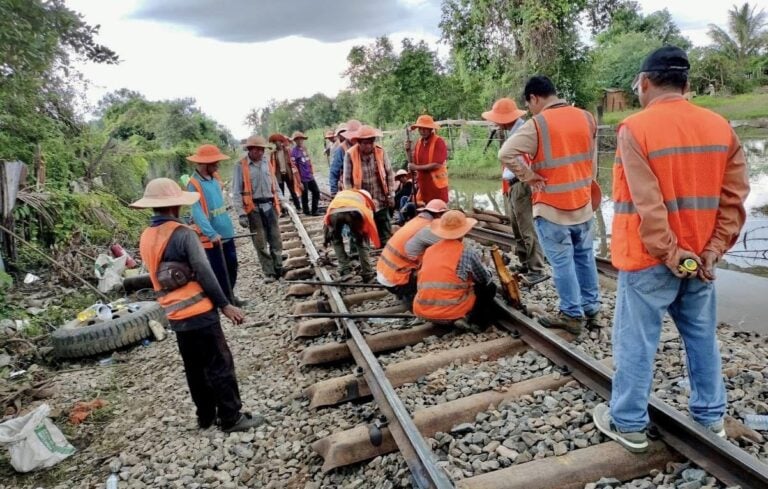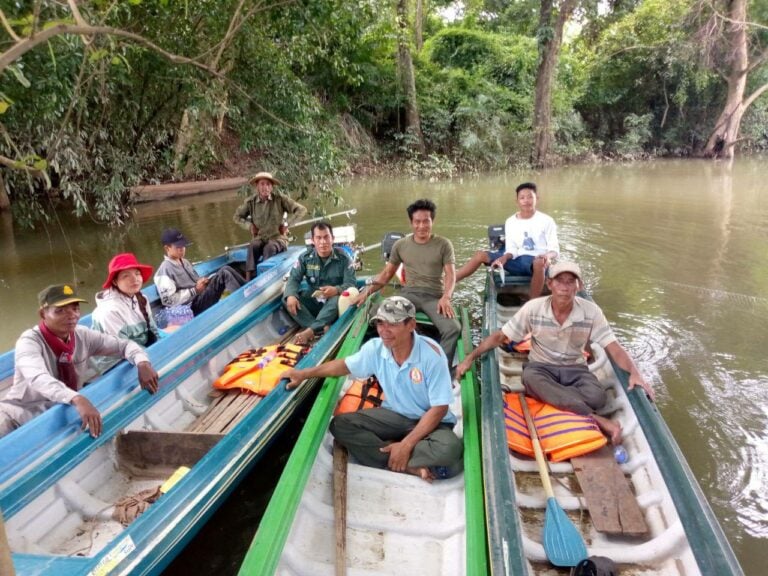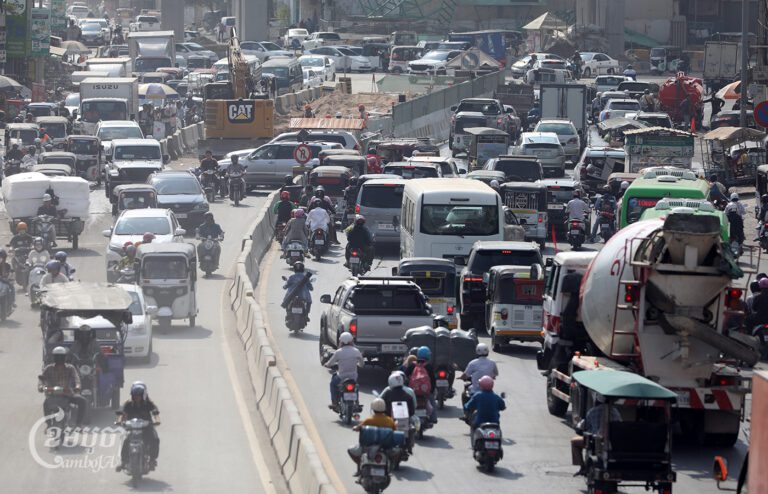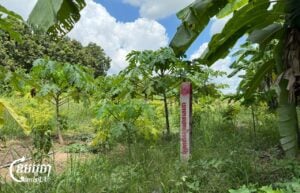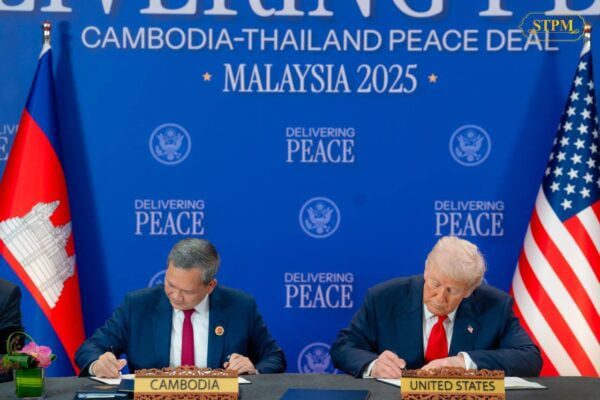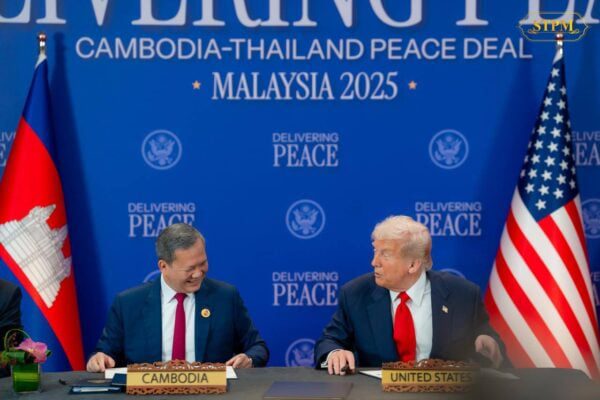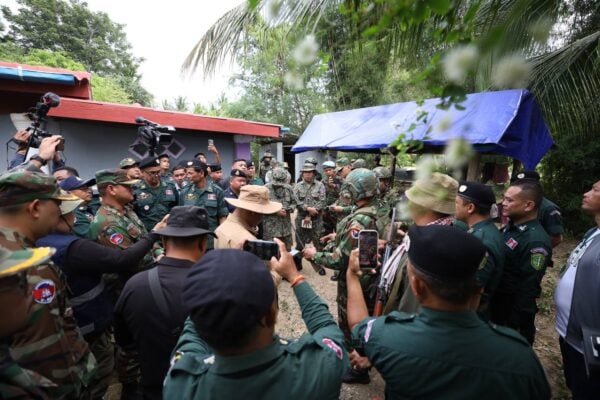In the early morning of late March 2024, a group of volunteers waited at the train station in Phnom Penh. They were about to embark on a journey that would leave them misty eyed after hearing what people went through during the Khmer Rouge regime.
Many of those they interviewed were evacuated from cities and taken by train to remote work camps between April 1975 and January 1979.
The volunteers were part of CamboCorps, an initiative launched in 2021 by the Documentation Center of Cambodia (DC-Cam) whose young members took part in various initiatives. These range from helping aging Cambodians who lived through that era receive medical care to documenting their experience for the archives to understand the nation’s past better.
During its briefing to the participants, DC-Cam said the study trip was an opportunity to comprehend what the “forced transfers by train” had been for people during the regime and how it impacted their lives, and to experience the train travel as thousands did back then.
The participants wore t-shirts bearing DC-Cam’s logo, an image of a garuda wielding a sword in one hand and a Angkear-Bos flower in the other. The garuda is a mythical winged creature in Hindu and Buddhist scriptures, portrayed as a vigilant protector. According to the logo, the sword signifies the preservation of people’s stories and the Angkear-Bos flower represents justice and memory.
The Journey Begins
Thick smoke billowed out of the train as it pulled out of the station. The trip to Mongkol Borey in the northwest of Cambodia was about 330 kilometers away from Phnom Penh. The railway was built in the early 1930s during the French Protectorate in Cambodia.
According to Chan Samut, who worked on the railway during the Khmer Rouge regime, the railway was repaired with the help of Chinese technicians after the soldiers captured Phnom Penh. He was a railway guard, where he was literally stationed on the roof, from 1975 to 1976.
“After [we] repaired and reconnected the railway, people were forcibly moved from Phnom Penh to Battambang by train,” said the 75-year-old.
Samut recalled guarding the train transfers from Phnom Penh to Kampong Chhnang, Pursat and Battambang, totaling more than 10 transfers at the time.
People were forced to travel from various parts of the country. “It was a mixed [crowd] including people from Svay Rieng, but most were from Phnom Penh who were dropped off at the Boeung Khna station. They brought the people and dropped them off at various stations. Only the top [Khmer Rouge leaders] knew about it […] we just followed their orders.”

In the end, around 500,000 people would be transferred to the northwest zone. “Those who were killed were mostly from Svay Rieng,” Samut said.
Accordingly, the first phase of the forced transfers started on April 17, 1975, as soon as the Khmer Rouge took control of Phnom Penh. The second phase took place in the regime’s central, southwest, west and east zones from September 1975 until 1977 while the third phase happened in the late 1977 to 1978 where people were moved out of the east zone.
‘Thrown in the fire’
During the forced transfers, people’s identities as human beings were erased, family members separated without saying goodbye.
“Each carriage was filled with people, with 10 to 15 cargo carriages packed,” Samut said, adding that the carriages were meant to carry goods, not humans. There was also no food or water for the people on board.
When a carriage was full, people would be directed to the next one even though it meant separating families. The same happened when they arrived at their destination. People were simply loaded onto vehicles, separating parents, siblings and relatives.
Asked by a CamboCorps member why people did not attempt to escape at that moment, Samut said, “[h]ow […] while [their] family members were still on the train.”
In one of the trips, people were killed in front of Wat Rumlech pagoda when the train arrived in Bakan district in Pursat province, he said.
The line’s last station at the time was Serei Sorphoan in the Khmer Rouge’s northwest zone. It is in the northwest zone that the Khmer Rouge would see a purge in their own ranks in 1977. “The [Khmer Rouge] regional committees in this zone were sent to the S-21,” Samut said, referring to the regime’s extermination camp in Phnom Penh.
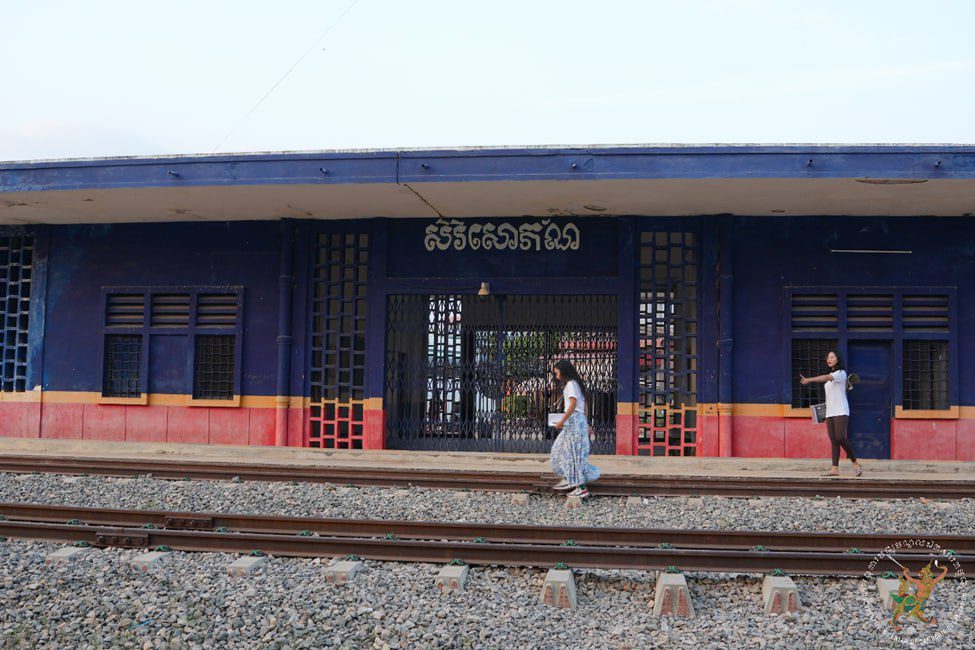
After an eight-hour journey by train, which felt longer due to the hot weather, the CamboCorps members reached their first destination – Serei Sorphoan city in Banteay Meanchey province. They began interviewing Yam Mony, an aging survivor of the Khmer Rouge regime who lived next to the station.
“One day, I sneaked away to visit my parents, unfortunately the Khmer Rouge [soldiers] caught me,” Mony related her story.
“A few hours after that,” Mony said, “I was thrown into the flames with other people.” He managed to get out but was struck in the back when a Khmer Rouge [soldier] threw a knife at him. Thankfully, he added, he was able to hide in the paddy fields until the soldiers left.
Taken away to be killed at night
Near the Wat (Pothi Keo) Preah Net Preah pagoda, the CamboCorps group met Hong Huy, who was transferred from Kandal village in 1975 to a nearby village in Kaun Damrei where he stayed for a month. While there, he witnessed the death of Yern, a deputy commune chief, and his entire family.
Yern was the deputy commune chief in the early 1970s, during the Lon Nol regime, whose army the Khmer Rouge defeated, enabling them to seize power in April 1975. Huy said the murder of Yern and his whole family was in line with a Khmer Rouge saying, “to be rid of weeds, one must remove the roots”.
“Chaiya, a son of Yern, was killed in the forest with a hoe. His daughter Kosy was shot dead later,” Huy recalled. Another child of the family was killed by a Khmer Rouge cadre, who bashed him against a palm tree.
In late 1975, Huy said, people who had been brought by train to the Sisophon station and taken by tractors to workcamps in the Preah Net Preah district. “Around 300 to 400 families were moved to Trapeang Veng [village],” he said. Huy and his family were also taken to that village after spending three months in another village.
“At the time, people were forced to transfer by train from Takeo, Prey Veng, Akrei Khsat, and Phnom Penh to Battambang, Pursat, and Svay [Serei Sorphoan],” he said.
Three members of Huy’s family died during that period, his mother-in-law, sister-in-law and his child. “Even though [the Khmer Rouge] did not directly kill them, [they] died due to lack of medicines, and starvation,” Huy said.
Song Pharat had a similar tragic story to tell. “At nighttime, people were taken away to be killed,” she said.
The 60-year-old especially remembers four Khmer Rouge men – Comrade Han, Comrade Aun, Comrade Morn, and Comrade Ron – who had come from the east zone to Preah Net Preah district. They showed no mercy for people, she said, adding that a few of them were still alive.
“People were killed in front of pits,” Pharat said, “so that the bodies could be thrown into them afterwards.”
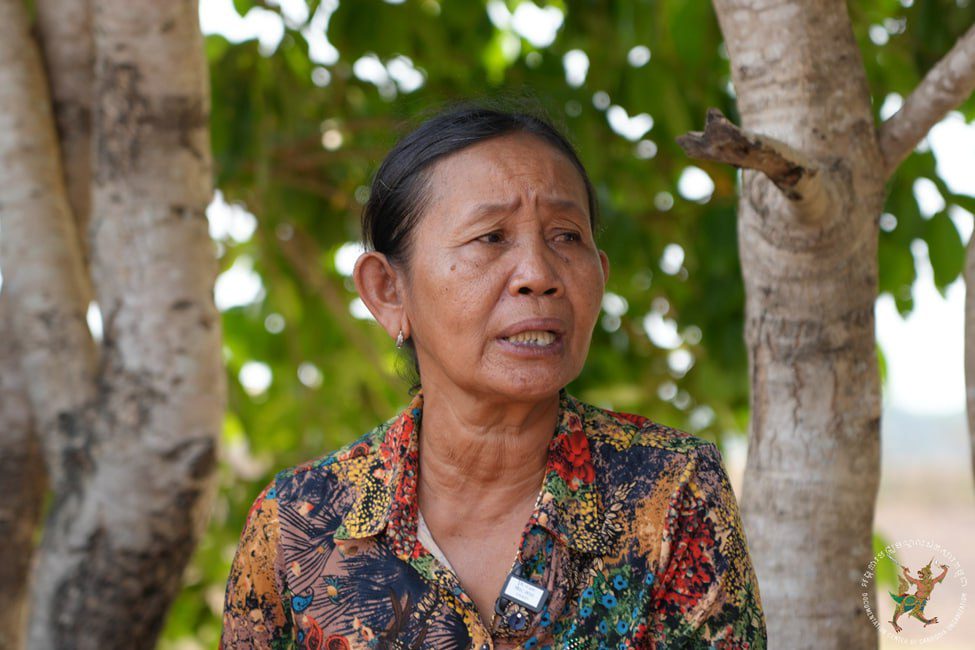
Put to farm work at the time, she would work until midnight, with a break of about 30 minutes during the day. She said even if she told the younger generation now about their treacherous lives then, “they wouldn’t believe me.”
According to Khmer Rouge documents, more than 50,000 people from the east zone were taken to other places. Some 8,000 to 10,000 people from the zone, including Svay Rieng and Prey Veng provinces, were eventually killed.
In 2015, Im Chaem, who was believed to have been secretary of the Preah Net Preah district during the Khmer Rouge regime, was charged with crimes against humanity at the Khmer Rouge Tribunal, otherwise known as the Extraordinary Chambers in the Courts of Cambodia (ECCC), and for grossly breaching the 1949 Geneva Conventions.
What if stones could speak
A site near the place where people, who arrived by trains were killed by the Khmer Rouge, was the Wat Preah Net Preah pagoda, “The Khmer Rouge used this pagoda as a health center,” Huy said.
In front of it was a rice paddy field and a pond with a waterwheel to irrigate the field in the dry season, said Pharat. “It had been there […] for around 100 years until the Khmer Rouge destroyed it,” she added.
“I was a monk at the pagoda before the Khmer Rouge regime,” said 73-year-old Sal, who did not disclose his family name. “Some stupas from the Sangkum era [Prince Norodom Sihanouk’s regime in the 1960s] are still there.”
The head of the Buddha statue at the pagoda was chopped off during the Khmer Rouge regime, he said. After the end of the regime, the statue was repaired and painted gold and has been displayed for worshippers at the pagoda, he said.
Like Huy and Pharat, Sal was transferred to Phnom Sreh village by the Khmer Rouge soldiers.
The CamboCorp group continued their journey, visiting an Angkorian temple in Banteay Chhmar and its vast site.
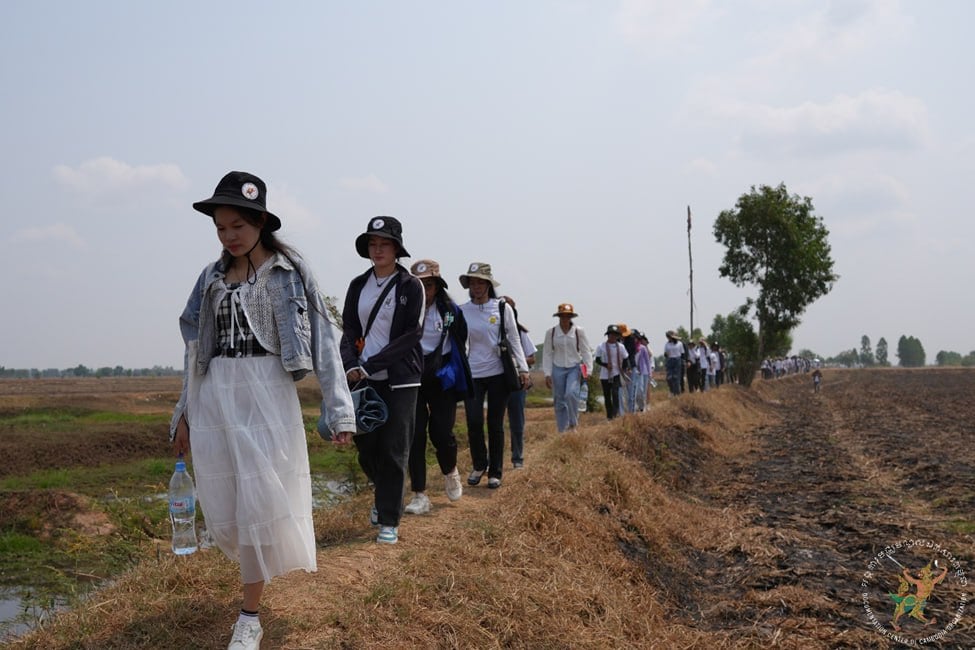
The temple was built during the reign of King Jayavarman VII between the late 12th and early 13th centuries. But it was heavily looted in the early 1970s civil war, then from the 1980s and well into the 2010s..
Banteay Chhmar was put on the tentative list of the UNESCO World Heritage Site at the request of the Cambodian government.
The group found that the temple was in a sorry state due to extensive damage. “As a [Cambodian] youth, as well as a CamboCorps [member], we should protect and preserve the heritage of our ancestors,” Him Sreyloeng, one of the members, said.
Lao Mala, a CamboCorps member from Stung Treng province, said, “Having visited the temple, I hope that if I choose history as my major [at university], I will be able to help preserve our heritage.”
Another member, Teh Rofikin asked who was responsible for protecting Cambodian heritage. “Perhaps, every Cambodian,” he said.
The visit was followed by a meeting with Youk Chhang, executive director of DC-Cam, during which the documentary film, “What If the Stones Could Speak” was played. Afterwards, Chhang posed a poignant question. “What if there was no Khmer Rouge regime,” he asked, raising the issue of what could have happened in the country.
Through determination and peaceful efforts, attaining freedom is possible even if it seems impossible. Chhang reminded the CamboCorps members of Indian non-violence advocate Mahatma Gandhi’s mission. He said Mahatma secured India’s independence from Great Britain in 1947 through a strategy of non-violence. He insisted on traveling third class rather than first class on trains, and who had told people, “[b]e the change you are trying to create.”
A traumatized old monk at Wat Rumlech
During a visit to Wat Rumlech pagoda, Venerable Prak Sarin, its 90-year-old chief monk, said he used to be a teacher in Pursat province before the Khmer Rouge regime. When the Lon Nol government took over in 1970, Sarin resigned from his teaching position due to differences of political opinion.
He moved to Kampot province but returned to Bakan three years later, he told CamboCorps members. During the regime, his sibling’s entire family was killed in Kampot.
Sarin was arrested in 1977 after being identified as a former teacher with connections. Fortunately, a man whom he had helped in the past was working at the detention center. “[H]e helped me survive [in the center],” he said.
After the downfall of the Khmer Rouge regime, Sarin worked as a school principal but left to become a monk.
In the Bakan district, more than 10,000 people, who were brought to the area during the regime, were killed. Grave sites were even found on the Rumlech pagoda grounds. A stupa was built at the pagoda in their memory, Sarin said.

Sarin admitted having come out of the Khmer Rouge regime traumatized, as did many Cambodians. One woman whose mother was killed at Wat Rumlech has never been able to return to Cambodia. “It affected all of us,” DC-Cam’s Chhang chimed in.
As development and infrastructure projects multiplied in Cambodia, sites such as the one at the pagoda may be overlooked and built over if they are not identified as historical sites, the CamboCorps members said.
Sao Hong, who is from Kep province, said she did not realize that there was such a site in her province until the Khmer Rouge survivors told her. “I’m afraid that if we don’t do anything about these places [by making them] historical sites they will be forgotten.”
Train’s role in 1993 National Elections
Following the signing of the Paris Peace Agreements in 1991, which marked the end of the civil war in Cambodia, the railway from Sisophon to Phnom Penh was repaired so that Cambodians in refugee camps in Thailand could come home. Starting 1992, the train, dubbed the Sisophon Express, would collect people from Sisophon city in Banteay Meanchey province bordering Thailand, to bring them home as they rode a 12-hour journey.
The Sisophon Express also played a vital role during the 1993 National Elections where people traveled to their hometowns to vote. This prompted the CamboCorps members to discuss the importance of voting, which they opined was a person’s right to democracy and an opportunity to be involved in political decisions.
In a democracy, voters are writing history as they choose their leaders, they said, citing the phrase “history is not finished”, which was uttered by Sergio Vieira De Mello, director of Repatriation and Resettlement Operations of the United Nations Transitional Authority in Cambodia.
Drawing similarities to Germany’s racial purity with the Holocaust happening from the late 1930s through 1945, the Khmer Rouge committed atrocities to achieve a classless society in Cambodia.
More than six million Jewish people’s lives were lost in Nazi concentration camps in Europe during the Second World War. In Cambodia, more than two million lives were lost on the “killing fields”.
On foot or by any mode of transportation, be it boat, truck, tractor, oxcart or train, forced transfers occurred all over the country. More than 20,000 burial sites have been found across Cambodia, and also along the railway tracks and stations from Phnom Penh to Mongkol Borey in Banteay Meanchey province.
After traveling by train and listening to the Khmer Rouge survivors, Chhon Na, a CamboCorp member from Pursat, said, “I regret not believing my grandparents.” The stories of survivors made Na realize the misery people went through during the regime. But not just her, the rest felt the same, pondering Youk Chhang’s question – what if the Khmer Rouge never happened?




